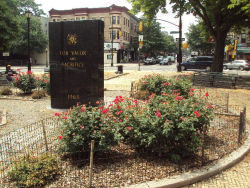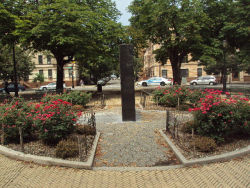Bartel-Pritchard Square
Bartel-Pritchard Square War Memorial
This site, at the intersection of Prospect Park West and Prospect Park Southwest, was named by the Board of Aldermen on April 10, 1923 after two young Brooklyn natives, Emil Bartel (1895-1918) and William Pritchard. Bartel and Pritchard both died in combat in France during World War I (1914-1918). Bartel resided nearby at 251 Windsor Place and Pritchard lived at 128 Linden Street in Bushwick. The men were close personal friends, both enlisting in Brooklyn’s 13th Regiment of the National Guard. During the War, they served in the 59th Regiment, Coast Artillery.
World War I (1914-1918) began after the assassination of Archduke Francis Ferdinand in Sarajevo on June 28, 1914. War ensued, pitting France, Great Britain, and Russia against Germany, Austria-Hungary, and the Ottoman Empire. The United States initially declared its neutrality, but this decision soon changed when Germany announced in February 1917 that it would no longer respect the neutrality of the seas, instructing U-boat commanders to attack any Allied vessel. President Woodrow Wilson (1856-1924) protested this action and within three weeks the U.S. formally declared war on Germany and its allies.
The sheer numbers of fresh U.S. troops finally tipped the balance of favor toward the Allied forces, and the long stalemate was broken. German forces collapsed under the weight of war and of political revolt in their home country, and sought out an end to the conflict. An armistice was signed on the eleventh hour of the eleventh day of the eleventh month of 1918.
The most striking feature of World War I was the unprecedented human devastation it caused. It is estimated that of the 61.5 million soldiers who fought in the war, from the European trenches to the Far East, 8.5 million were killed, 7 million were permanently injured or maimed, and an additional 12.5 suffered recoverable injuries. Because of its late entry into the war the United States suffered among the fewest losses, at approximately 116,000.
Memorial ceremonies in honor of the war dead were held throughout the participating countries on the first anniversary of the war’s end, November 11, 1919. President Wilson proclaimed this day “Armistice Day.” Following the lead of France and Great Britain, the United States laid an unknown soldier to rest in Washington, D.C. on November 11, 1921. In the following years, 27 states adopted laws declaring November 11 a legal holiday, and the day was officially named “Armistice Day” on June 4, 1926. Following the United States’ encounters with warfare in World War II (1939-1945) and Korea (1950-1953), on June 1, 1954, President Dwight D. Eisenhower (1890-1969) signed a bill renaming Armistice Day “Veterans Day.”
In 1965 the Patrick J. Devaney Post #964 erected this polished black granite monument in memory of the men of the community who gave their lives in wartime defense of their country.
Check out your park's Vital Signs
Clean & Safe
Green & Resilient
Empowered & Engaged Users
Share your feedback or learn more about how this park is part of a
Vital Park System



